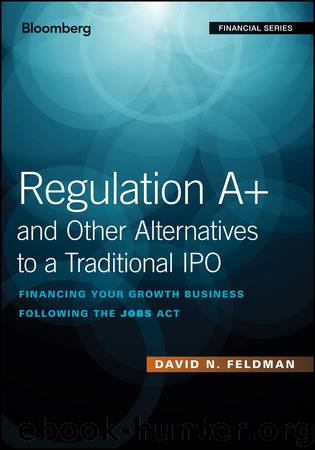Regulation A+ and Other Alternatives to a Traditional IPO by David N. Feldman

Author:David N. Feldman [Feldman, David N.]
Language: eng
Format: epub
ISBN: 9781119416128
Publisher: Wiley
Published: 2018-02-05T00:00:00+00:00
Other Issues
Raising the Limit
As mentioned previously, the SEC has the right to increase the $50 million limit that a Reg A+ issuer can raise in a 12‐month period. They must assess this under the JOBS Act at least every two years and report to Congress only if they do not raise the limit, and explain why they have not. As we know, since the passage of the JOBS Act in 2012 the limit has remained unchanged.
Given that FundRise and apparently others have successfully raised multiple $50 million Reg A+ IPOs, many believe the SEC should consider offering more companies the opportunity to take advantage of the benefits of Reg A+. I had a client planning a $75 million IPO. They will be burdened by the TTW restrictions in traditional Form S‐1 offerings and have to endure much more comprehensive SEC review for what appears to be no particular reason. As noted above, the Financial CHOICE Act, passed by the House of Representatives in June 2017 on party lines, would mandate an increase in the Reg A+ limit to $75 million. I recently had a call with a group of attorneys who represent IPO underwriters who said a change from $50 to $75 million could significantly increase their clients' potential interest in Reg A+. That increase also was recommended by the 2017 Conference.
The argument for keeping the limit in check, however, appears to be that the SEC is willing to risk greater fraud in smaller deals, allowing them to feel comfortable with the much more limited review of Reg A+ offering statements. If Reg A+ were to increase to, say, $200 million, the risk obviously becomes greater. The context of this view is worth exploring in a little detail.
The SEC has made clear in recent years that they wish to use much more of their enforcement resources to prevent the next Bernard Madoff or Enron. For those less in the know or not as grizzled as your author, both were multibillion‐dollar frauds. In the case of Madoff, a former Wall Street pillar was convicted in 2009 of a massive Ponzi scheme in which he kept raising new money to pay back to prior investors what appeared to be tremendous gains in investments.
The allegation was that over $16 billion was stolen or paid back illegally. Roughly $9 billion of it was ultimately recovered and returned to investors. Madoff had stolen, however, from his high school buddies and friends. Many lost their entire life savings. The lesson one hopes many learned was never to place all your eggs in one basket, and also that in many cases when something sounds too good to be true it probably is.
Enron was one of the largest U.S. companies in the oil industry. In order to make their performance look better, their crafty CFO moved certain key assets (and related liabilities) off their balance sheet through complex, ultimately proven to be illegal, machinations. In December 2001, the company filed for bankruptcy as a result of the fraud, and several key executives ended up in jail.
Download
This site does not store any files on its server. We only index and link to content provided by other sites. Please contact the content providers to delete copyright contents if any and email us, we'll remove relevant links or contents immediately.
| Private Equity | Valuation |
| Venture Capital |
The Black Swan by Nassim Nicholas Taleb(7010)
Bad Blood by John Carreyrou(6552)
Pioneering Portfolio Management by David F. Swensen(6226)
Millionaire: The Philanderer, Gambler, and Duelist Who Invented Modern Finance by Janet Gleeson(4374)
Skin in the Game by Nassim Nicholas Taleb(4161)
Bullshit Jobs by David Graeber(4094)
The Money Culture by Michael Lewis(4076)
Skin in the Game: Hidden Asymmetries in Daily Life by Nassim Nicholas Taleb(3929)
The Wisdom of Finance by Mihir Desai(3651)
Blockchain Basics by Daniel Drescher(3507)
Liar's Poker by Michael Lewis(3368)
Fooled by Randomness: The Hidden Role of Chance in Life and in the Markets by Nassim Nicholas Taleb(3044)
Hands-On Machine Learning for Algorithmic Trading by Stefan Jansen(3027)
The Intelligent Investor by Benjamin Graham Jason Zweig(2995)
Mastering Bitcoin: Programming the Open Blockchain by Andreas M. Antonopoulos(2981)
The Power of Broke by Daymond John(2897)
Investing For Dummies by Eric Tyson(2894)
Market Wizards by Jack D. Schwager(2643)
Zero Hour by Harry S. Dent Jr. & Andrew Pancholi(2614)
